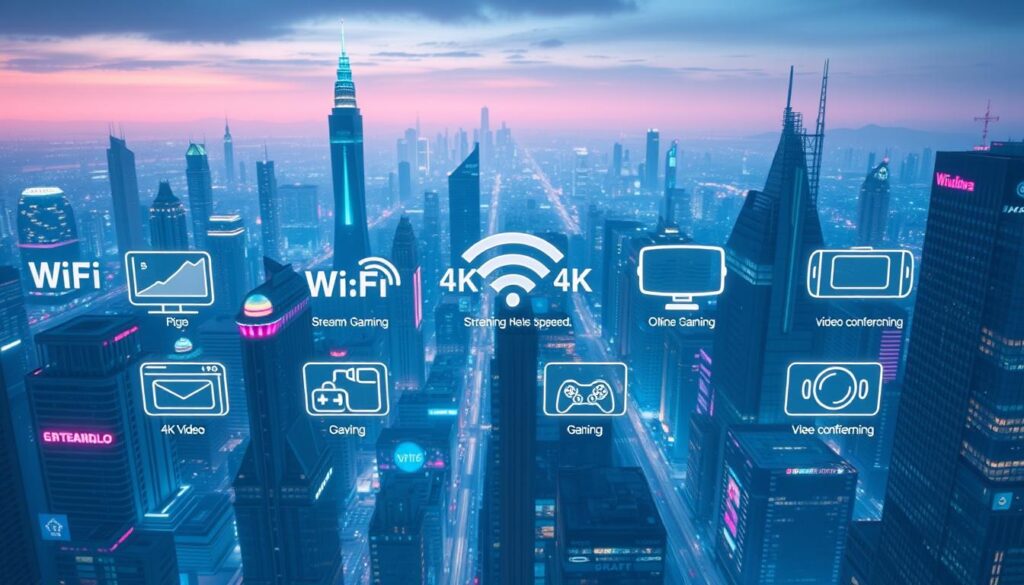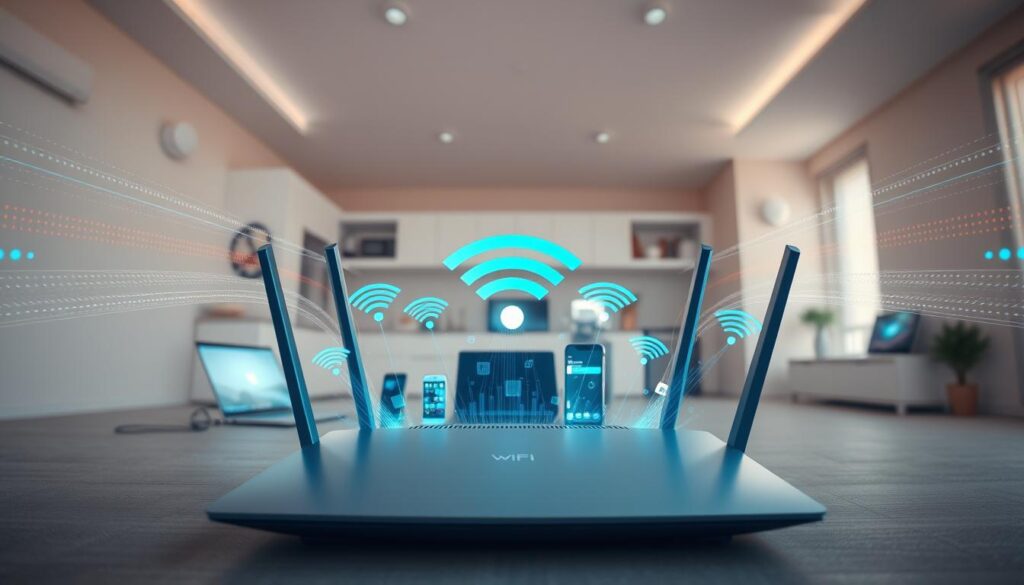In today’s world, fast and reliable internet is key. OpenVault’s latest report shows that in the first quarter of 2025, the average household used 564 Mbps in download speeds and 34 Mbps in upload speeds. This shows how much we need faster internet.
As we use the internet more, knowing how to make it better is vital. This guide will help you understand the importance of wifi optimization. It will also give you tips to boost your internet speed.
Key Takeaways
- Understand the average internet speeds in the US
- Learn how to optimize your wifi for better performance
- Discover the factors that affect your internet speed
- Get tips on how to improve your network performance
- Stay up-to-date with the latest trends in wifi optimization
Understanding WiFi Speed Fundamentals
WiFi speed is key to our digital lives. It affects streaming and online gaming. Knowing the basics of WiFi speed is essential for a better internet experience.
What WiFi Speed Actually Means
WiFi speed is how fast data moves between devices on a network. It’s measured in megabits per second (Mbps) or gigabits per second (Gbps). Faster speeds mean you can do more online without slowdowns.
The Difference Between Bandwidth and Throughput
Bandwidth and throughput are often mixed up, but they’re not the same. Bandwidth is the network’s data capacity at any time. Throughput is the actual data transferred. Think of bandwidth as a highway’s width and throughput as the traffic on it.
Common WiFi Standards and Their Maximum Speeds
WiFi standards vary in speed. Wi-Fi 6 (802.11ax) can reach up to 9.6 Gbps. Wi-Fi 6E uses the 6 GHz band for faster, lower-latency connections. The new Wi-Fi 7 promises even faster speeds and better performance in busy areas.
| WiFi Standard | Maximum Speed | Frequency Band |
|---|---|---|
| Wi-Fi 5 (802.11ac) | 3.5 Gbps | 5 GHz |
| Wi-Fi 6 (802.11ax) | 9.6 Gbps | 2.4 GHz, 5 GHz |
| Wi-Fi 6E | 9.6 Gbps | 2.4 GHz, 5 GHz, 6 GHz |
Newer WiFi standards have higher speeds and use more frequency bands. This reduces interference.
Average WiFi Speeds in 2025: What to Expect
Internet technology keeps getting better, so knowing about WiFi speeds in 2025 is key. This year, WiFi speeds will hit new highs thanks to tech progress and how we use the internet.
Current US Broadband Statistics
The FCC says a good internet connection is at least 100 Mbps download and 20 Mbps upload. The US average speed is now about 150 Mbps, but it changes a lot by area.
Urban vs. Rural Speed Disparities
There’s a big difference in WiFi speeds between cities and countryside. Cities get faster internet because of better setup and more competition. But, rural places are slower because of fewer people and higher costs.
A study showed cities average 200 Mbps, while rural areas get about 50 Mbps.
Global WiFi Speed Comparisons
WiFi speeds vary worldwide. Countries like South Korea and Singapore have the fastest speeds, over 300 Mbps. The US is among the top 20 countries for WiFi speed. Knowing this helps us see how our internet compares globally.
In summary, WiFi speeds in 2025 will show both tech progress and location differences. As tech keeps improving, we’ll see faster speeds everywhere, closing the gap between cities and countryside.
Factors That Affect Your WiFi Speed
Many things can change your WiFi speed. This includes the hardware you use and the environment around you. Knowing what affects your speed can help fix any problems.
Internet Service Provider Limitations
Your Internet Service Provider (ISP) has a big impact on your WiFi speed. They offer different plans with different speeds. If your speed is too slow, upgrade your plan to meet your needs.
Router Hardware Capabilities
Your router’s abilities also matter a lot. Older routers or those with lower specs might not work well with new WiFi standards. Think about getting a newer router that supports WiFi 6 or WiFi 6E for better speeds.
Distance and Physical Obstructions
The distance to your router and any physical barriers can slow down your WiFi. The farther away or more obstacles there are, the weaker the signal. Improving your router’s location can help a lot.
Interference from Other Devices
Other devices and nearby WiFi networks can also slow you down. Things like microwaves and cordless phones can cause problems. Use tools to find and switch to less crowded WiFi channels to improve your speed.
By understanding and fixing these issues, you can make your WiFi faster and more reliable.
How to Test Your WiFi Speed Accurately
Testing your WiFi speed is easy to do. It helps you see if your internet is working right. Knowing this can tell you if your internet service is up to par.
Recommended Speed Testing Tools
There are many tools to test WiFi speed, but some are better than others. Ookla’s Speedtest is top-notch because it’s reliable and has lots of features. It even lets you see how your speed has changed over time. Fast.com by Netflix is also great for a quick download speed check.
Understanding Speed Test Results
When you run a speed test, you’ll see three key numbers: download speed, upload speed, and ping. Download speed shows how fast data comes to your device. Upload speed is how fast data goes from your device to the internet. Ping tells you how long it takes for data to go to a server and back.
When and How Often to Test
It’s smart to test your WiFi speed at different times. This helps you see how your network performs at various times. Testing during busy hours and quiet times gives a full picture of your internet. Testing regularly, like once a week or month, can spot ongoing WiFi speed problems.
Interpreting Your WiFi Speed Test Results
After running a WiFi speed test, it might seem hard to understand the results. But, it’s key to better your online experience. Your test will show download and upload speeds, ping, and sometimes more like jitter and packet loss.
What Good Download and Upload Speeds Look Like
A download speed of at least 100 Mbps is good for most online tasks. Upload speeds of 20 Mbps are also recommended. For example, Netflix needs 25 Mbps for 4K streaming, and Zoom wants an upload speed of 3 Mbps for HD video.
It’s normal for download speeds to be much higher than upload speeds. This is because most internet use is downloading.
The Importance of Ping and Latency
Ping, or latency, shows how long data takes to travel to a server and back. Lower ping times are better. High latency can slow down real-time apps like online gaming or video calls.
For most users, a ping under 50 ms is good. But, for serious gamers, anything over 20 ms is too high.
Jitter and Packet Loss Explained
Jitter is the variation in ping times, affecting real-time app performance. Packet loss happens when data packets don’t reach their destination. This can cause internet service issues.
While some jitter and packet loss are normal, high levels can mean problems with your internet service provider or network setup.
Knowing these metrics helps you find and fix WiFi connection problems. By understanding your WiFi speed test results, you can improve your internet experience.
WiFi Speed Requirements for Common Activities
To enjoy uninterrupted streaming, gaming, and video conferencing, knowing the required WiFi speeds is key. Different online activities have different needs for your internet connection. Understanding these needs can help you optimize your WiFi setup.
Video Streaming Requirements (4K, HD)
For smooth video streaming, the WiFi speed needed depends on the resolution. For example, 4K content requires at least 25 Mbps. On the other hand, HD streaming needs around 5 Mbps. But, these speeds can change based on the streaming service and how many devices are connected.
Online Gaming Needs
Online gaming needs more than just high speeds. It also needs low latency and a stable connection. A minimum speed of 3 Mbps is recommended for most games. But, for a seamless experience, higher speeds and lower ping times are key, even more so for multiplayer games.
Video Conferencing and Remote Work
For video conferencing and remote work, a fast and stable internet connection is essential. At least 1 Mbps upload speed is recommended for standard definition video conferencing. For high-definition conferencing, you’ll need 2-4 Mbps. If you have multiple participants, you might need even higher speeds.
Smart Home Device Bandwidth Usage
Smart home devices, though not very bandwidth-intensive, can affect your WiFi network. Devices like smart speakers and security cameras might need around 1-2 Mbps each. While this might seem small, many devices can strain your network.

Knowing these WiFi speed requirements helps you manage your internet better. It ensures your connection can support your digital lifestyle.
10 Proven Ways to Improve Your WiFi Speed
Online content is more popular than ever. A fast internet connection is now a must for work and fun.
Optimal Router Placement Strategies
Improving your WiFi speed starts with the right router spot. Place it in the middle of your home or office. This boosts coverage and cuts down on dead spots.
Also, put your router up high or on a wall. This spreads the signal better.
Avoid metal objects and other devices near your router. They can mess with your WiFi speed. “Where you put your router really matters,” says a networking pro.
Updating Router Firmware
Keep your router’s firmware current. Updates boost speed, fix problems, and add security. Log in to your router to check for updates.
Changing WiFi Channels to Reduce Interference
Other networks and devices can slow your WiFi. Switching channels helps. Use a WiFi analyzer to find the best channel and change it in your router settings.
Using Quality of Service (QoS) Settings
QoS lets you pick which traffic gets more bandwidth. This means video calls or games run smoothly. It’s all about keeping your network running well.
Implementing Mesh Network Solutions
Mesh networks are great for big spaces. They use many access points for better coverage and speed. Say goodbye to dead spots and hello to a reliable network.
Try these tips to make your WiFi faster and more reliable. Whether it’s where you put your router, updating it, or using mesh networks, there are many ways to boost your online experience.
Advanced WiFi Speed Optimization Techniques
Optimizing WiFi speed involves understanding new WiFi standards and using the right hardware. It’s key for handling tasks like 4K streaming and online gaming. This ensures your network can keep up with your needs.
WiFi6 and WiFi6E Benefits
WiFi6 and WiFi6E bring big improvements over older standards. WiFi6 uses OFDMA for better efficiency in crowded areas. WiFi6E operates in the 6 GHz band, giving more bandwidth and less interference.
Key benefits of WiFi6 and WiFi6E include:
- Faster data transfer rates
- Improved performance in crowded environments
- Lower latency
- Better capacity for IoT devices

Ethernet vs. WiFi: When to Use Wired Connections
Ethernet connections are more reliable and faster than WiFi. They’re great for tasks like online gaming, video editing, or big file transfers. This is because Ethernet offers a stable connection.
| Connection Type | Speed | Reliability | Use Case |
|---|---|---|---|
| Ethernet | Up to 10 Gbps | High | Gaming, Video Editing |
| WiFi | Up to 9.6 Gbps (WiFi6) | Medium | General browsing, Streaming |
Network Segmentation Strategies
Segmenting your network can boost performance. It isolates devices or apps that use a lot of bandwidth. You can use VLANs or QoS settings to manage traffic.
Using WiFi Analyzers to Identify Problems
WiFi analyzers help spot issues like channel overlap or weak signals. They let you fine-tune your WiFi setup for better performance.
Security Settings That Impact WiFi Speed
Your WiFi’s security settings can be both a blessing and a curse. They protect your network but might slow it down. It’s important to know how different security levels can change your WiFi’s speed.
WPA3 vs. Older Security Protocols
The newest WPA3 security protocol is a game-changer. It offers top-notch security without slowing down your WiFi too much. Switching to WPA3 means a safer connection without losing too much speed.
VPN Usage and Speed Considerations
VPNs make your connection safer but might make it slower. This is because they add extra encryption and routing steps. The speed hit depends on the VPN service and where its servers are.
Balancing Security and Performance
Finding the right balance is key. WPA3 is usually a good choice for most users. If you need even more security, using a VPN for certain tasks can be a good compromise.
| Security Protocol | Speed Impact | Security Level |
|---|---|---|
| WPA2 | Low | Medium |
| WPA3 | Minimal | High |
Troubleshooting Common WiFi Speed Issues
Fixing WiFi speed problems needs a careful plan to find and fix the main issue. WiFi issues can come from many places. So, it’s key to check each part carefully.
Diagnosing Sudden Speed Drops
Speed drops can happen due to other devices or things blocking the signal. Try restarting your router first. If it doesn’t work, look for updates and make sure your router is in the best spot.
Resolving Router Overheating Problems
When routers get too hot, WiFi speed suffers. Keep your router cool and away from other hot things. If it’s old or not working right, get a new one that handles heat better.
Addressing Network Congestion
Too many devices on one network can slow it down. Try using fewer devices or get a better router. You can also set up Quality of Service (QoS) to make sure important stuff works well.
When to Contact Your ISP
If you’ve tried everything and WiFi is slow, call your ISP. They can help if it’s a bigger problem. They might check for outages or send someone to fix it.
Conclusion
As we depend more on the internet, keeping WiFi speed up is key. This guide shows why knowing about WiFi speed is important. It also talks about how to test and improve it.
Keeping your WiFi speed high means staying current with new WiFi standards. WiFi 6 and WiFi 6E are on the horizon, promising faster speeds. By understanding what affects your WiFi and optimizing your network, you’ll get a faster, more reliable connection.
As we use the internet more, keeping up with new WiFi tech is vital. Adopting the latest WiFi and best practices will prepare you for a connected future. This ensures a strong, stable WiFi connection for years to come.



